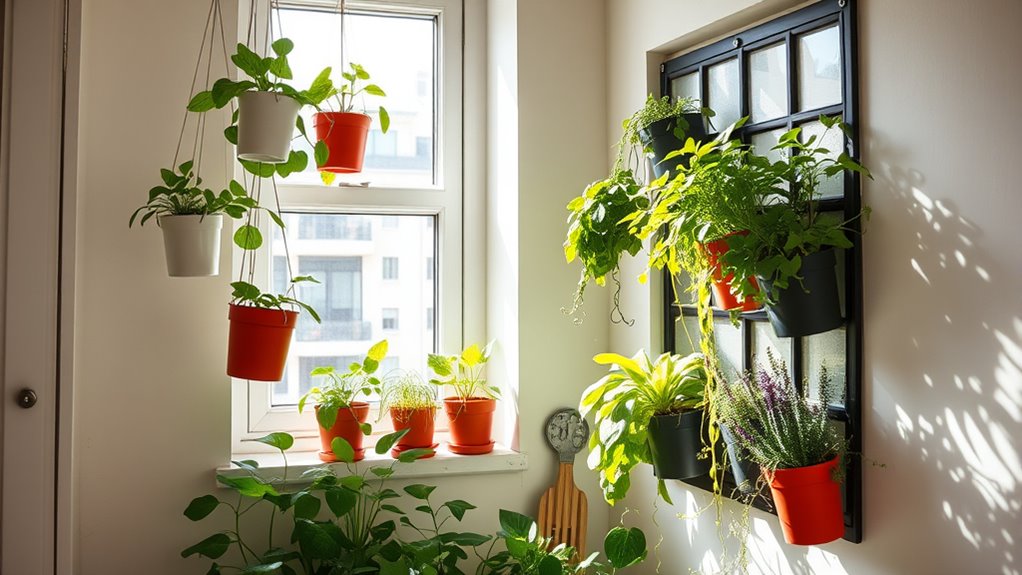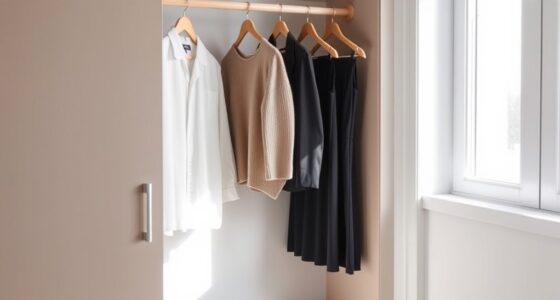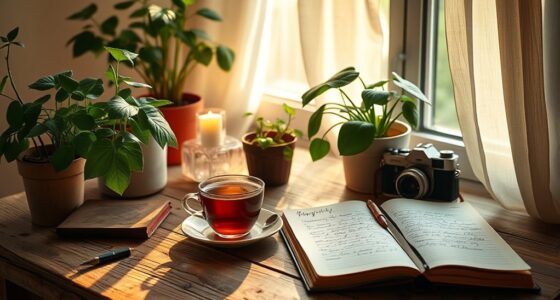To maximize your tiny apartment’s green space, use vertical gardening with wall-mounted planters, hanging baskets, and repurposed pallets to save floor area. Opt for small, productive plants like herbs and compact vegetables, and select space-efficient containers. Incorporate trellises for climbing plants and eco-friendly pest control methods to keep your garden healthy. Smart lighting and cohesive designs boost beauty and function. Keep exploring for more tips to transform your space into a lush, practical oasis.
Key Takeaways
- Maximize space with vertical gardening using wall-mounted planters, hanging baskets, and trellises.
- Choose compact, dwarf, or herb plants suited for small containers and limited areas.
- Use repurposed materials like pallets and shoe organizers for creative vertical garden solutions.
- Incorporate natural pest control methods such as ladybugs and organic sprays to maintain plant health.
- Enhance aesthetics with cohesive plant choices, proper lighting, and decorative containers for a stylish, functional garden.

Ever wondered how to make the most of limited space in your city apartment or small balcony? The good news is, with a few clever tricks, you can transform even the tiniest area into a thriving green oasis. One of the best ways to maximize space while keeping your gardening eco-friendly is by adopting sustainable pest control methods. Instead of harsh chemicals, you can introduce natural predators like ladybugs or use homemade organic solutions such as neem oil or garlic spray. These approaches protect your plants without harming the environment or introducing toxins into your living space. Combining sustainable pest control with smart design strategies ensures your garden stays healthy and vibrant without compromising your health or the planet. Creating a cohesive aesthetic by choosing plants and containers that complement each other can also enhance the overall harmony of your urban garden. Vertical planting techniques are game-changers for small spaces. Instead of spreading out horizontally, you build upward, saving precious floor space. Think about installing wall-mounted planters, hanging baskets, or even repurposing old pallets or shoe organizers into vertical gardens. Not only do these methods help you fit more plants in a limited area, but they also add a decorative touch to your balcony or apartment walls. When choosing plants for vertical planting, opt for herbs like basil, mint, or parsley, which thrive in confined spaces and are handy for cooking. Small vegetables like cherry tomatoes or peppers can also be grown vertically, making your garden both functional and beautiful. To make the most of vertical planting techniques, consider using lightweight containers and ensuring proper drainage. Use wall anchors or sturdy hooks to support the weight of your planters and prevent accidents. You can also incorporate trellises or lattice panels for vining plants, which climb upward and create lush, green walls. This setup not only maximizes your space but also provides privacy and shade, making your apartment feel more like a personal retreat. Another tip is to choose compact or dwarf varieties of plants suited for small pots or containers. Regularly prune and harvest to keep plants healthy and prevent overcrowding. Additionally, selecting efficient lighting solutions can enhance plant growth in limited spaces, especially indoors or in shaded balconies. Proper soil quality is also crucial for healthy plant development, so use organic compost and amend your soil regularly. Incorporating garden design principles can further improve the usability and aesthetic appeal of your urban garden. Remember, sustainable pest control practices fit perfectly with vertical gardening since they reduce the need for chemical interventions and keep your space safe for both you and your neighbors. By combining vertical planting techniques with eco-friendly pest management, you can create a sustainable, efficient, and attractive urban garden even in the tightest of spaces. It’s all about thinking vertically, staying eco-conscious, and making every inch count.
Frequently Asked Questions
How Can I Prevent Pests in Small Indoor Gardens?
To prevent pests in your indoor garden, start by choosing pest-resistant plants that naturally ward off bugs. Use composting tips to avoid overwatering and mold, which attract pests. Keep your space clean, remove dead leaves, and regularly inspect your plants. Introducing beneficial insects like ladybugs can also help control pests naturally. These steps create a healthy environment, reducing pests without harsh chemicals, ensuring your tiny garden thrives indoors.
What Are the Best Plants for Low-Light Apartment Spaces?
Think of your apartment as a cozy forest where every plant plays a essential role. For low-light spaces, you should choose plants like snake plants, pothos, and ZZ plants—they symbolize resilience and adaptability. These green friends improve indoor air quality and require minimal plant maintenance tips, making them perfect for shaded corners. With such companions, your apartment becomes a lush sanctuary, thriving despite limited sunlight.
How Often Should I Water My Tiny Container Plants?
You should water your tiny container plants based on their specific needs, but generally, follow a consistent watering schedule—usually once every few days. Always check container drainage; if water pools at the top, it’s a sign you’re overwatering. Confirm your pots have proper drainage holes, and avoid letting plants sit in excess water. Adjust your watering routine as needed, especially during warmer or cooler months, to keep your plants healthy.
Can I Grow Vegetables Indoors Year-Round?
Yes, you can grow vegetables indoors year-round. To do this successfully, use the right plant lighting options like grow lights to guarantee your plants get enough light, especially during darker months. Incorporate composting tips to enrich your soil or compost indoors for sustainable growth. Keep your plants in a warm, consistent environment and water them appropriately. With these strategies, you’ll enjoy fresh vegetables anytime, even in a tiny apartment.
What Are Space-Saving Methods for Vertical Gardening?
To save space in your vertical garden, you can hang planters from ceilings or wall-mounted shelves to maximize your limited area. Use wall-mounted shelves to create multiple levels for your plants, making the most of vertical space. Hanging planters are perfect for trailing plants or herbs, freeing up your floor and counter space. Combining these methods helps you grow more in a tiny apartment, making your urban gardening efficient and stylish.
Conclusion
By trying these urban gardening hacks, you can transform even the tiniest apartment into a lush oasis. Did you know that over 80% of city dwellers with limited space successfully grow herbs or small vegetables? So, don’t let your small space hold you back—get creative and enjoy fresh produce right at home. With a little effort, you’ll soon be reaping the benefits of your green thumb, no matter how compact your apartment is.










